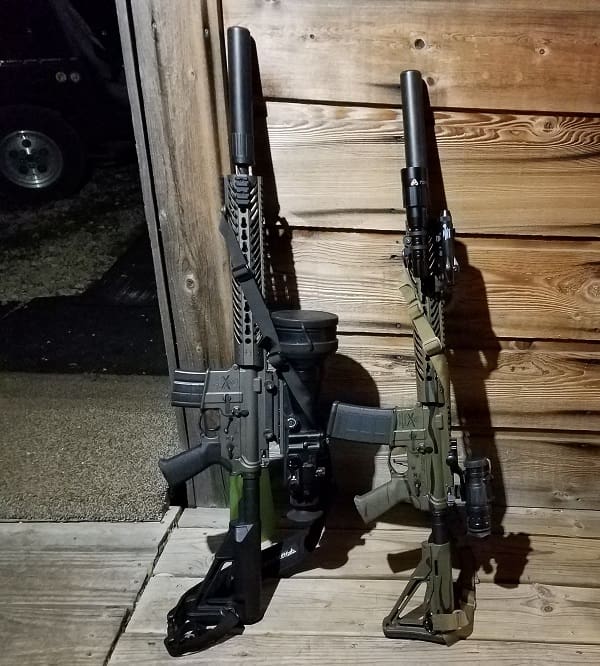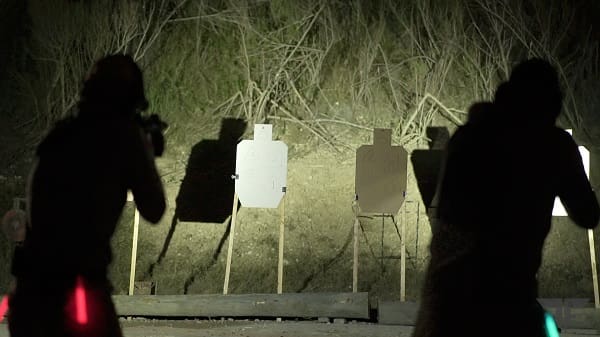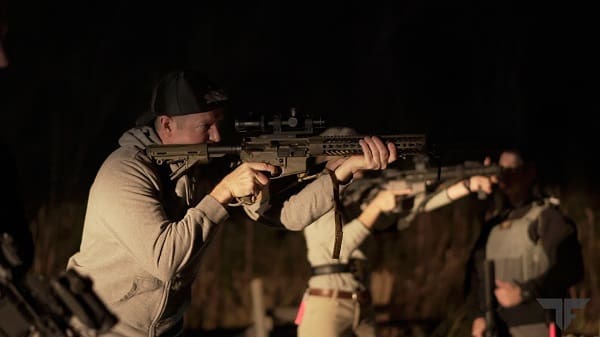I shoot a lot at night. Between shooting on my own home range and hunting pigs and varmints almost exclusively at night, I get quite bit of practice putting lead on target in the dark. But it’s almost never with a visible light . . .
Instead, I use a series of Night Optical/Observation Devices that turn night into day. I’ve also been in combat at night, quite a bit. But there again, I very rarely used white light, relying instead on the NODs issued to me. Thank you, good tax payer, they were most welcome.
At home, I have a dedicated night time .458 SOCOM SBR set up with an AN/PVS-14 and a AN/PEQ-2 for anything that should provoke my ire whilst I slumber. I do keep an AR with a powerful visible light in my truck for the random hog on the farm, but that’s static shooting off the door of my truck, usually at targets 100 yards away.
By now you probably see the problem: it’s been almost 10 years since I had done any tactical training with my rifle using a visible light. And complacency kills.

When Ron Grobman told me he had a slot available for his Mini Combat Rifle Low Light Course, I jumped on it riki tik. I’m glad I did.
Grobman is a former IDF Special Operations Sniper who runs Tactical Fitness in Austin, Texas. I took a couple of courses from him earlier this year, and found them to be outstanding. (I will definitely be signing up again for his VCQC course this spring.)
This “mini rifle” course is Ron’s introduction to night time shooting with a rifle-mounted white light. As the “Mini” in the course title would suggest, this is not comprehensive, scenario driven training. The course lasts just over two hours total. The goal: gain a basic understanding of rifle shooting under low- to no-light conditions.
Throughout the course Ron emphasizes that he’s giving students the basics to take home and practice on their own.

The course started about 30 minutes prior to sunset at a private outdoor range in Austin. Ron set up cardboard silhouettes at the 25 yard line.
Everyone on the course was running an AR15 in 5.56 NATO, except for Ron, who ran his Tavor. The course was open to beginner students with a safe working knowledge of their firearm and equipment.
Ron runs all of his drills with dry fire prior to loading live ammunition. He adds to the safety factor by loading a plastic rod down each barrel. With the bore completely obstructed, it’s impossible to load a round into the weapon. That’s very much appreciated; students can try new things with their weapons and remain safe.
After the safety briefing, Ron covered the basics: an aggressive stance, sight alignment, sight picture and trigger control. By then it was nightfall. We engaged the targets standing still from the low ready.
Immediately things got tricky.
I’m used to the NODs being on; I just pick up the rifle and find my target. With white light, there are extra steps. You need to come out of concealment, fire and then return to concealment.
Instead of finding the target, flicking off the safety, firing, and putting the safety back on, you’ve got to turn the light on, scan for your target, find your target, take the safety off, fire, return the safety and turn the light off.

I’ve said it before, and I’ve proven it over and over again. I’m an idiot in combat. To overcome my strategic stupidity, I drill tasks until I don’t have to think about them. Inserting something into that process — even something as simple as turning the light on and off — is particularly difficult.
I know I’m not alone. My beam was often pointing at the ground or the sky long after I’d engaged my target, depending on whether I was at the high or low ready. This was compounded when we started working reloads in the dark.
Fortunately, I was trying out a new piece of kit: a new silent capture spring system. I say fortunately because it didn’t work well on my rifle, and choked pretty quickly, making my rifle fail to return to battery often. That provided me with a great training opportunity to fix errors in the dark.
Ron also showed the class how to scan above your scope, not behind it, when your white light is on. That way you can maintain full situational awareness while using the outer glow of the light instead of wandering around the target with the beam.
That super bright spot is a blessing far away, but a curse up close. On the way over, I knew the light I had with me was probably too powerful for short ranges. I was correct.
The Streamlight TLR1-HPL I keep in the truck for spotting hogs at night completely flooded out the black targets on a brown silhouette 25 yards away. It’s great for spotting those pigs, or telling the difference between a pig and a deer in a field at night, but not so great for defense.
By looking over the top of my scope’s turrets and not focusing the tight beam on my target, I could recognize that target and get my gun up to it much faster than attempting to look through my scope, even if it was a 1X optic.
The last bit of instruction prior to live fire: moving laterally along the firing line, then engaging targets upon command, using both your own weapon-mounted light or the ambient light from another student’s weapon.

Live fire was pretty much a duplication of the dry fire exercises. I appreciate the walk-before-you-run approach.
By the end of the night, we were putting it all together in a series of drills. We’d move along the firing line until a partner would call out a series of targets. The goal: change positions for each target, as well managing any stoppages and reloading your weapon quickly, without the use of a light source.
Once again, we all found that the simple act of turning the light on and off was challenging in the middle of everything else we were doing. But that’s what it’s all about.
The advantage of a weapon-mounted white light: you can be concealed in darkness, appear only to quickly acquire a target and fire, and then disappear into the darkness, only to reappear somewhere else.
That’s a powerful advantage, but one that only works if you can effectively manage that light. While moving. While searching. While firing. While reloading. In combat. And that’s a whole lot harder than it sounds.
Grobman teaches a slew of courses, including a Mini Pistol Low Light course, as well as longer courses. This course was just about perfect for an introduction. It provides the basics, giving you a lot to go home with. There was zero wasted time, and you aren’t asked to do endless drills of the same thing, effectively paying someone to do your homework in class.
On the administrative side, the course was run well. I got an email about two weeks before the course laying out the itinerary, round count, what to bring, etc. and then another reminder a couple of days before with additional information, as well as directions and contacts. All I had to do was show up and sign in. Again, no wasted time.
All in all, I really dig the short format Ron offers. Get in, pack those few hours full of instruction, and get home to practice on your own. The whole thing was an eye opener for me, and a skillset I’ve let go for far too long.
Tactical Fitness Mini Combat Rifle Low Light Course
Full 2018 Course Schedule now open.




Shooting in darkness is great fun
It is always interesting to see how much of a fireball a gun makes
Even with a flash suppressor
The Steyr Aug shoots a jet of fire at right angles to the bore from the gas tube vent
I would love to buy night vision, but they are so expensive and I have a lot of other gun stuff to buy before that
I’ll buy a high end thermal before I buy a night vision scope. They issue PVS14s (gen 3) in the USMC, take it from a grunt, don’t waste your money unless you are using it strictly for observation.
I roll a 56MM objective on my rifle, it lets in enough light that I can see well enough out to 200 meters. I haven’t taken it out at night anywhere I could get more distance. I also haven’t got around to turning on the illuminated reticle yet, but I should probably take the battery out before it corrodes. Night force NXS 5.5-22×56
Doc, I put one of these on a dedicated 300BLK SBR lower and haven’t looked back. It’s great to 75 yards for pigs and other varmints and in sale i got it for under $500. It’s sweet and reasonable for entry.
https://www.google.com/amp/a/s/www.opticsplanet.com/atn-x-sight-ii-day-night-riflescopes.html%3F_iv_amp%3D1?ampru=https://www.opticsplanet.com/atn-x-sight-ii-day-night-riflescopes.html?_iv_amp%3D1%26gclid%3DEAIaIQobChMIlJLAzNHS1wIVg4uzCh2uegGGEAQYASADEgLZM_D_BwE&s=ALQMoTcO7Rh3T45Un6ZJM7gdty6U-6YAHw
There’s another bit of information that didn’t make it of the editing room floor.
I experienced a squib load during the course. It was, oddly enough, my second in two weeks, using two different rifles in different calibers. In this case, the round felt like it didn’t go off, but then the rifle attempted to chamber another round, which failed to fully enter the chamber. As I was taught, I performed SPORTS, in the dark, and a firm Tap on the forward assist finally brought the bolt all the way home. But that little red light in my head was going off.
Folks, pay attention to that little red light. If something doesn’t feel right on your rifle, check it out. Looking into the chamber on the firing line showed no issues, so I stepped back and broke open the rifle. I pushed a cleaning rod down the front of the barrel to find that it made it about 13 inches down on a 16 inch barrel. I was able to tap the bullet out and keep going with the course.
If I had not, if I had just performed the remedial action to get the gun back in the fight and pulled the trigger, the results would have been catastrophic.
Holy cow, TWO squibs?! Really glad you were paying attention and you were able to get them out.
Were these reloads?
Interesting course. Not for me but I’m sure there are plenty who will wish to try it out.
“Were these reloads”?
They were both commercial rounds, but I have no idea if they were from once fired brass. One was American Eagle M193 and the other was Freedom Munitions Boar Buster 90gr 6.8SPC.
Anyone else on the line have any (squibs) ? Have you checked on Lot/Batch recalls?
With the extremely low failure rate of primers, it was probably a lack of powder charge. It’s a problem that ‘hides’ itself during production, but can happen even to automated systems with stringent QC.
” But that little red light in my head was going off.
Folks, pay attention to that little red light.”
*This*.
Psychologically, it’s kinda tough to do. There’s a strong motivation to blow it off.
“Nah, it was nothing. I’m being paranoid.”
Good training for that is to have owned an un-reliable car in the past. *Listen* to what the machine is telling you, it can save you from a long walk or a busted-ass gun…
Second that. I once avoided a shooting into a squib when i noticed some unburt powder on the bolt of my ar after i racked the round out.
Awesome review as always Jon. In your opinion what’s the ideal ratio between running live fire drills and instructing/teaching during a course? In the classes you have taken, does the instructor usually spends 30% of the time teaching/going over the drills and 70% of the time shooting?
It depends on the material, but generally I prefer more instruction and dry fire drills, with live-fire used as validation. It’s just so much easier to communicate with a class prior to having rounds in the gun and the lack of a live weapon allows you to have a greater level of safety while learning new techniques.
I would prefer something closer to 50/50, or even 70/30, with the minority of the time in live fire. The more complex the movement or task, the more time needs to be spent in dry fire.
80$ ain’t bad. JWT you sure make it sound complicated though.
$80? That’s something I’d be willing to shell out for some experience in. I’m still very new to night shooting, so that would be some welcome training.
Comments are closed.